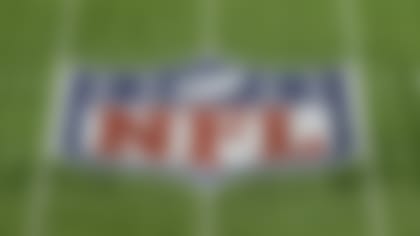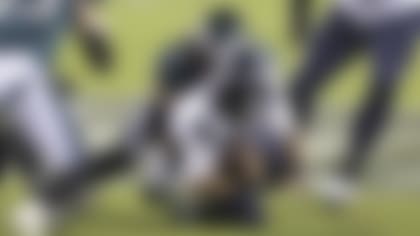Like so many other parts of life during the pandemic, football looks different this year. To play this NFL season, it takes a multi-faceted effort to tackle the challenges of COVID-19.
To keep players, coaches and personnel as safe as possible in the team environment, the NFL and NFL Players Association's health and safety protocols are aimed at mitigating the spread of COVID-19. A robust testing program and comprehensive contact tracing program are key features of the protocols, which also cover every aspect of a club's operations, including physical distancing and facility modifications.
"Risk mitigation is not one intervention, but a number of interventions you stack together in the hopes that the combination will be more effective than any of them individually," said NFL Chief Medical Officer Dr. Allen Sills.
"Our number one goal is to keep everyone safe and make sure that as best we can no one steps onto the field on gameday that is infected – whether that be player, coach or other personnel."
Robust Testing Protocols
One of the key risk management strategies the NFL and NFLPA are employing this season is daily COVID-19 testing, with the help of BioReference Laboratories (BRL), which uses a national system of laboratories separate from local health care resources.
Before any player or staff member was allowed access to club facilities for training camp, they underwent an intake process, which included multiple tests taken over consecutive days. Any new player or personnel entering the facility for the first time throughout the season must undergo five days of consecutive testing, with negative results, before being granted access.
"We instituted that very deliberately based on experience from other sports to try to reduce the risk of anyone coming in and infecting a team environment," said Dr. Sills.
Monitoring testing for players and staff continues daily and results of those tests are available within 24 hours. The COVID-19 monitoring testing results numbers are shared publicly every week.
If a player has a positive result without symptoms of COVID-19, he needs to wait until ten days have passed to return to football activities.
If a player has a positive test accompanied by symptoms, he needs to wait at least ten days from the time symptoms first appeared, and at least 72 hours since he last experienced symptoms.
When any player or personnel tests positive, a comprehensive contact tracing effort is also undertaken to identify and isolate exposed individuals.
A Modern Approach to Contact Tracing
The COVID-19 pandemic has created an unprecedented need for contact tracing – and in turn, a need for innovative approaches to contact tracing.
The league is using a new technology to assist in this critical step to mitigate the spread of COVID-19. And it has been deployed league-wide as a core component of the NFL's COVID-19 health and safety protocols.
A lightweight, wearable device, called a Proximity Recording Device, is mandatory for players and club personnel when at the club facility, during practices, and during team travel. About the size of a watch face, the device is worn as a wristband or on a lanyard. Players even have them built into their equipment for use on-field in practice and games.
The device gathers information about individuals' proximity to each other – by distance and length of time – in order to speed the process of contact tracing and help enforce physical distancing by notifying users with lights and sound if they are too close to one another. It's a novel solution for an historically cumbersome process.
That data is combined with additional information the league collects as part of its contact tracing process, like interviews with individuals involved and video from inside a club facility, to identify "high-risk close contacts" – individuals who have been exposed to a confirmed positive individual. High-risk close contacts are immediately isolated and not allowed to return to the facility for a minimum of five days since the last exposure.
More than 24 high-risk close contacts have later tested positive for COVID; their identification and swift isolation has likely prevented further spread of the virus within the team.
Using data from the contact tracing process, clubs also continue to evolve their approach to safety. If data show close contacts during one aspect of a club's routine, like during team travel, solutions like increasing the number of buses to allow for physical distancing are implemented.
Club Facility Measures
Club facilities underwent a transformation this year – from layouts to cleaning protocols.
Players and club staff are thoroughly screened every time they enter a facility. This includes a temperature check and a COVID-19 questionnaire as additional precautions to protect the team environment.
Once inside, players find reconfigured locker rooms that allow for physical distancing, strategically placed hand sanitizer throughout the facility, and rigorous cleaning practices in place to ensure high-touch surfaces are consistently and thoroughly sanitized.
Since COVID-19 is most commonly spread through contact from one person to another, players and staff are being asked to take extra precautions this year to protect each other.
"One of the most important things that you can do is to wear a face covering, such as a cloth face mask or a neck gaiter pulled up over the nose and mouth," said Dr. Sills.
It's also extremely important to maintain good hygiene practices. Consistent hand washing is vital, but it's equally important that players and team staff avoid sharing personal items like water bottles, towels and food. Posters hang around club facilities as reminders and steps have been taken to eliminate shared items.
Innovative Technology
Equipment innovation has long been at the core of the NFL's health and safety efforts. As players are required to wear a face covering at all times at the club facility, including on the practice field, channeling the entrepreneurial spirit to develop solutions that met this uniquely challenging moment was a logical transition for the league's medical experts and engineers.
"Like everything we do, whether we're talking about better cleats or better performing helmets, it's all about something that's safer and yet also protects performance," said Dr. Sills.
"That's the same mantra and the same sort of approach that we're taking with the Oakley mouth shield."
The mouth shield was designed by Oakley in partnership with the NFL and NFLPA's medical and engineering experts. Designed to fit inside the facemask of a helmet, it provides face coverage to help reduce the transmission of large respiratory droplets during active play in games and practices.
Players are required to wear a face covering at all times at the club facility, including on the practice field. The Oakley mouth shield is one piece of equipment they can choose to wear to meet that requirement.
In addition to innovating in preventative measures, the league has also evolved its COVID-19 surveillance program alongside the rapidly developing science. The daily testing program recently added the Mesa BioTech point-of-care PCR test that is as reliable as the 24-hour laboratory-based PCR tests but with rapid results – within 30 minutes or less.
Because of its robust testing program, the league served as the ideal proving ground for the efficacy of Mesa's point-of-care PCR test. Before rolling out the test league-wide, 917 tests were administered on both platforms – using Mesa's point-of-care PCR test and the 24-hour laboratory PCR test – for comparison. The results were identical. The finding is one that not only helps the NFL have confidence in its operations, but that could have implications for other areas of society also trying to navigate COVID-19.
An Ongoing Commitment to Safety
As medical and scientific knowledge of the virus has expanded, the NFL and NFLPA have evaluated and modified their COVID-19 protocols to reflect the most up-to-date understanding of the virus and its transmission – and will continue to.
"We expect our protocols to change and adapt based on what we're learning, and you'll see us continue to make changes as we gather more data throughout the course of the season," said Dr. Sills.
The NFL is in regular communication with public health experts, the CDC, and medical officials from other professional sports leagues, among others, as part of a two-way dialogue to share learnings that are applicable to other areas of sport and society.











